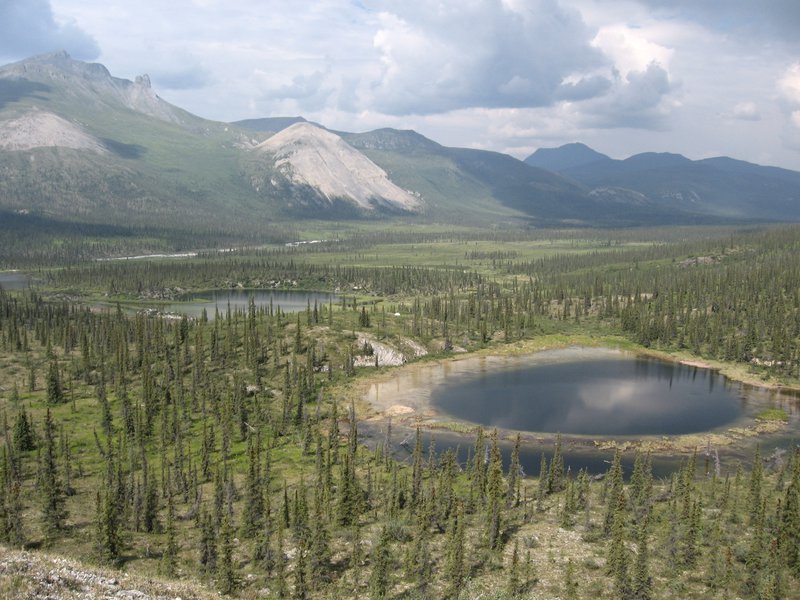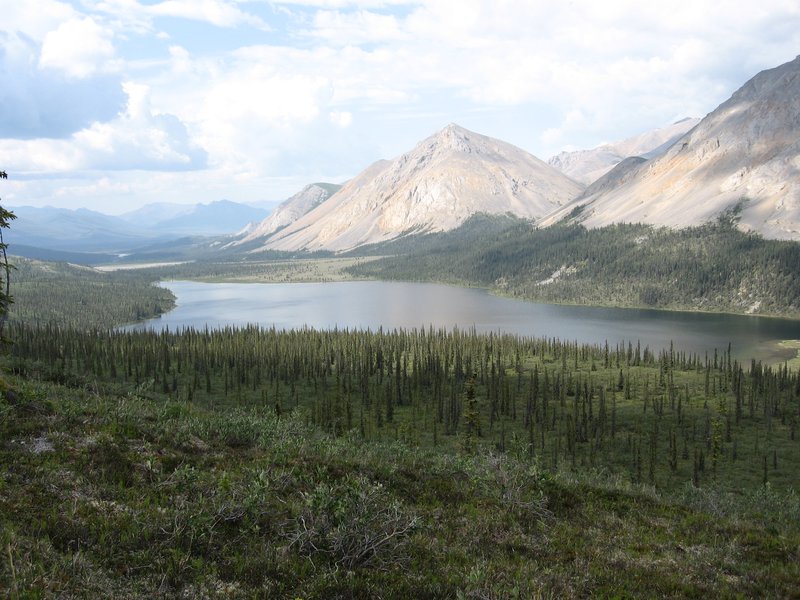Testing Boreal Forests’ Blood Pressure
A&S professor Melissa Chipman was awarded National Science Foundation grant funding to study the ancient geochemistry of Arctic forests to understand interactions between boreal fire and climate change.

Two lakes in a boreal forest dominated by flammable spruce, central Alaska. Photo credit: Melissa Chipman
Boreal ecosystems, dotted by subarctic lakes, are the world’s northern-most forests. The boreal biome is the largest on earth, stretching across Alaska, Canada, Russia and Scandinavia. These forests of spruce, fir and pine help regulate global climate, by sequestering carbon in biomass and soils and providing oxygen through photosynthesis. Yet, the health of carbon-rich boreal ecosystems depends on fires that release tree seeds from protective cones and allow forests to regenerate.
“You can’t have a boreal forest without fire,” says Melissa Chipman, assistant professor in the College of Arts and Sciences’ Department of Earth and Environmental Sciences.
But as the global climate has rapidly warmed, many boreal forests have become hotter and drier, increasing repeated blazes. “We are seeing far more boreal fires than we’ve ever seen before,” she says.

A recently burned boreal forest stand with early-successional fireweed, central Alaska. Photo credit: Melissa Chipman
Chipman is a paleoecologist who studies reconstructions of Arctic and subarctic ecosystems. She is a co-investigator of a National Science Foundation-funded project to understand the history of boreal fire over the past six thousand years and help anticipate climate change consequences in the future.
If fire frequency accelerates in boreal forests, it could cause dramatic forest losses, thaw permafrost and release additional carbon into the atmosphere, hastening further climate change.
The research team will undertake fieldwork and spatial analyses, assessing the severity of recent burns on the landscapes and the impacts on vegetation structure and composition, to determine how fire-resilient the landscape is today. The researchers will also use high-performance computer models to estimate how past warming or cooling temperatures and fire frequency have interacted and how they could interact in the future. The lead co-investigator is paleoecologist Philip Higuera at the University of Montana.
Chipman is focusing on the geochemical part of the research, studying the paleo history of boreal lakes, which contain fossil clues of fire and forest change buried in their sediment layers.
She will study sediment cores taken from boreal forest lakebeds. Different chemical indicators of past watershed responses to fire —such as nitrogen isotopes—are found buried in ancient sediments and can reveal how forest ecosystems have changed over the past 6,000 years.
“Testing sediment geochemistry is like taking someone’s blood pressure to see if they’re about to have a heart attack,” she says. “One of the first symptoms of a transition to a different type of ecosystem is to see a fundamental shift in the biogeochemistry.”

Melissa Chipman holding a freshly extracted sediment core from an Alaskan Lake. Photo credit: Briana Edgerton

Graduate students Briana Edgerton and Jessica Garrison processing lake sediments from a previous field expedition to Alaska. Photo credit: Melissa Chipman
During a warming period of increased burning 500 years ago, flammable species such as black spruce were outcompeted by flame-resistant ones such as quaking aspen, apparently allowing the boreal forest ecosystems to stabilize and guard against ecosystem collapse by becoming less flammable.
“We want to know what happened to nitrogen released in a boreal forest environment before and after a fire,” she says. “I will scan sediment cores to learn the elemental composition of nitrogen isotopes during periods of more fire versus periods of less fire.”

Keche Lake, site of one of the existing boreal fire records from Alaskan lake sediments generated by Melissa Chipman. Photo credit: Melissa Chipman
Nitrogen isotopes in sediment cores can indicate ecological processes that occurred in the watershed in the past. By looking at these signals, the researchers can learn whether enhanced past burning had caused a loss of nutrients from soils. Nutrient losses could be an indicator that the forest system was stressed.
The team is looking for clues about whether there were various ecosystem adaptations—such as changes in vegetation—that may have helped to stabilize or destabilize the boreal forest system. These clues could provide critical information about how a rapidly warming climate could affect boreal forests in the future.
“We’re starting to see dramatic changes now, and we need to help people understand what could happen,” says Chipman.
Featured
Melissa Chipman Research Assistant Professor: Arctic Paleoecology & Paleoclimate
